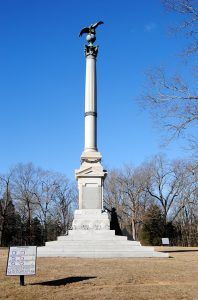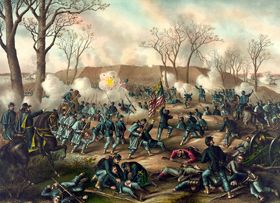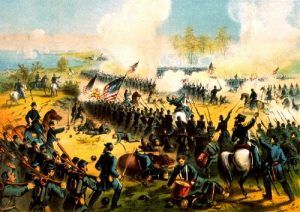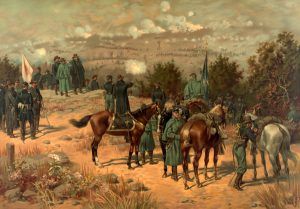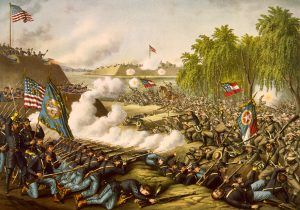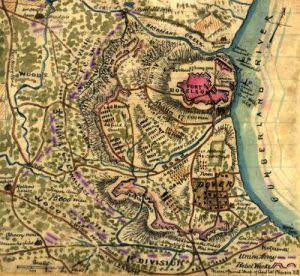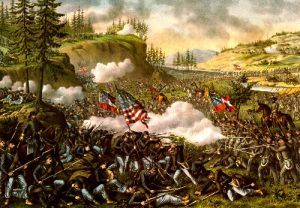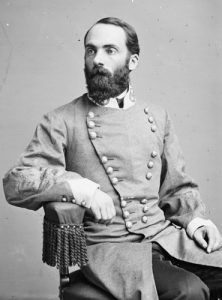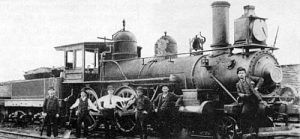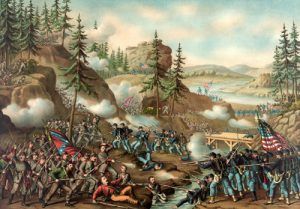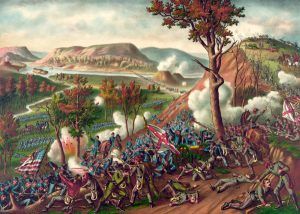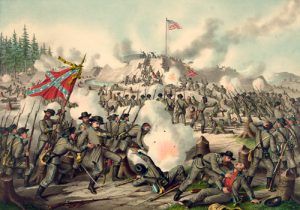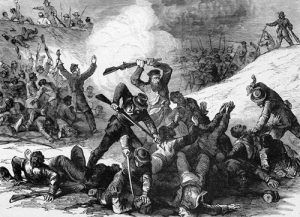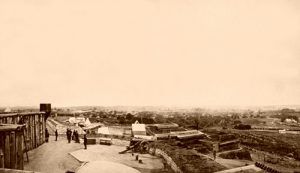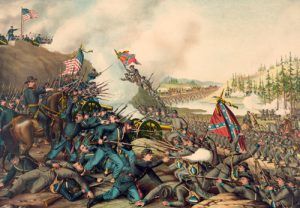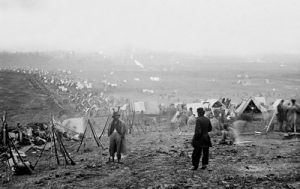Civil War Battles of Tennessee – Legends of America (original) (raw)
Monuments to the various regiments who fought in the Battle of Shiloh are located within the park.
Much of the Civil War was fought in Tennessee’s cities and farms; only Virginia saw more battles. Geography dictated a central role for Tennessee. As a border state with its rivers being key arteries to the Deep South, it was a significant target for the Federals. From the early days of the war, Union efforts focused on securing control of transportation routes, major roads, and mountain passes such as the Cumberland Gap.
Tennessee was one of the border states that sent many men to fight on both sides of the Civil War. A sizeable part of the male population — 187,000 Confederate and 51,000 Federal soldiers — mustered in from Tennessee.
Many important battles occurred in Tennessee, including the vicious fighting at the Battle of Shiloh, the deadliest battle in American History. Other large battles included Stones River, Chattanooga, Nashville, and Franklin. Making matters worse for the Tennessee Confederates were pockets of strong pro-Union sentiments, which remained throughout the war, particularly in East Tennessee’s mountains.
The Vice President of the United States, Andrew Johnson, was a loyalist, as were several congressmen and state politicians. On the Confederate side, significant leaders included noted cavalryman Nathan B. Forrest, corps Commanders Leonidas Polk and Benjamin F. Cheatham, and Governor Isham Harris.
When the war was over, Tennessee would see more than its share of devastation resulting from years of warring armies traveling through the state.
Tennessee Civil War Battles
Fort Henry (February 6, 1862)
Fort Donelson (February 11-16, 1862)
Shiloh (April 6-7, 1862)
Plum Run Bend (May 10, 1862)
Memphis (June 6, 1862)
Chattanooga (August 21, 1863)
Murfreesboro (July 13, 1862)
Hatchie’s Bridge (October 5, 1862)
Hartsville (December 7, 1862)
Stones River (December 31, 1862-Jan 2, 1863)
Lexington (December 18, 1862)
Jackson (December 19, 1862)
Trenton (December 20, 1862)
Parker’s Cross Roads (December 31, 1862)
Dover (February 3, 1863)
Thompson’s Station (March 5, 1863)
Vaught’s Hill (March 20, 1863)
Brentwood (March 25, 1863)
Franklin (April 10, 1863)
Hoover’s Gap (June 24-26, 1863)
Chattanooga (August 21, 1863)
Blountsville (September 22, 1863)
Wheeler’s Raid (October 1-9, 1863)
Blue Springs (October 10, 1863)
Wauhatchie (October 28-29, 1863)
Collierville (October 11, 1863)
Collierville (November 3, 1863)
Orchard Knob (November 23, 1863)
Lookout Mountain (November 24, 1863)
Missionary Ridge (November 25, 1863)
Campbell’s Station (November 16, 1863)
Siege of Knoxville (November 17-December 4, 1863)
Fort Sanders (November 29, 1863)
Bean’s Station (December 14, 1863)
Mossy Creek (December 29, 1863)
Dandridge (January 17, 1864)
Fair Garden (January 27, 1864)
Fort Pillow (April 12, 1864)
Memphis (August 21, 1864)
Johnsonville (November 4-5, 1864)
Columbia (November 24-29, 1864)
Spring Hill (November 29, 1864)
Franklin (November 30, 1864)
Murfreesboro (December 5-7, 1864)
Nashville (December 15-16, 1864)
Bull’s Gap (November 11-13, 1864)
Tennessee Battle Summaries:
Cumberland and Tennessee Rivers Campaign (February – June 1862)
Also called the “Mississippi River Campaign” and the “Fort Henry and Fort Donelson Campaign,” this force by the Union began on February 6, 1862, as a strategy to allow the North invasion routes by land and by water, as well as cutting off supplies to Confederate Forces. General Ulysses S. Grant moved swiftly, moving his troops down the Tennessee River toward Fort Henry on river transports on February 2 and coordinating with United States Navy Flag Officer Andrew H. Foote. The campaign ended with the Siege of Corinth, Mississippi, in May 1862.
Fort Henry (February 6, 1862) – Taking place on February 6, 1862, in Stewart and Henry Counties of Tennessee and Calloway County in Kentucky, this battle resulted in a Union victory. By the time of the attack, Fort Henry, a Confederate earthen fort on the Tennessee River with outdated guns, was partially inundated, and the river threatened to flood the rest. On February 4-5, Union General Ulysses S. Grant landed his divisions in two different locations, one on the Tennessee River’s east bank to prevent the garrison’s escape and the other from occupying the high ground on the Kentucky side, which would ensure the fort’s fall. At the same time, Flag Officer Andrew H. Foote’s seven gunboats began bombarding the fort. Commanding Fort Henry’s garrison, Confederate Brigadier General Lloyd Tilghman quickly realized that it was only a matter of time before Fort Henry fell. While leaving artillery in the fort to hold off the Union fleet, he escorted the rest of his force out of the area and sent them safely off on the route to Fort Donelson, some ten miles away. Tilghman then returned to the fort and, soon afterward, surrendered to the fleet, which had engaged the fort and closed within 400 yards. Fort Henry’s fall opened the Tennessee River to Union gunboats and shipping as far as Muscle Shoals, Alabama. After Fort Donelson’s fall, ten days later, the two major water transportation routes in the Confederate west, bounded by the Appalachians and the Mississippi River, became Union highways for moving troops and material. The conflict resulted in estimated casualties of 40 Union and 79 Confederate.
Battle of Fort Donelson, Tennessee, by Kurz and Allison, 1887.
Fort Donelson (February 11-16, 1862) – After capturing Fort Henry on February 6, 1862, General Ulysses S. Grant advanced cross-country to invest in Fort Donelson. On February 12-13, the Union made several small probing attacks, and on February 14, U.S. Navy gunboats under Flag Officer Andrew H. Foote attempted to reduce the fort with naval gunfire. However, they were forced to withdraw after sustaining heavy damage from Donelson’s water batteries. The next day, the fort was surrounded by Union troops, and the Confederates, commanded by Brigadier General John B. Floyd, launched a surprise attack against Grant’s army, attempting to open an avenue of escape.
Grant, who was away from the battlefield at the start of the attack, arrived to rally his men and counterattack. Despite achieving partial success, Floyd lost his nerve and recalled his men to their entrenchments.
On the morning of February 16, Floyd and his second-in-command, Brigadier General Gideon J. Pillow, turned over their command to Brigadier General Simon Bolivar Buckner, who agreed to unconditional surrender from Grant. The estimated casualties of the battle were 2,331 U.S. and 15,067 Confederate. This was a significant victory for General Grant and a catastrophe for the South. It ensured that Kentucky would stay in the Union and opened up Tennessee for a Northern advance along the Tennessee and Cumberland Rivers. Grant was promoted to major general for his victory and attained stature in the Western Theater.
Battle of Shiloh, Tennessee, by J.H. Bufford
Shiloh (April 6-7, 1862) – Also called the Battle of Pittsburg Landing, this battle occurred in Hardin County, Tennessee. As a result of Forts Henry and Donelson’s fall, Confederate General Albert Sidney Johnston, the commander in the area, was forced to fall back, giving up Kentucky and much of West and Middle Tennessee. He chose Corinth, Mississippi, a major transportation center, as the staging area for an offensive against General Ulysses S. Grant and his Army of the Tennessee before the Army of the Ohio, under Major General Don Carlos Buell, could join it. The Confederate retrenchment was a surprise, although a pleasant one, to the Union forces, and it took Grant, with about 40,000 men, some time to mount a southern offensive along the Tennessee River toward Pittsburg Landing. Grant received orders to await Buell’s Army of the Ohio at Pittsburg Landing.
Grant did not choose to fortify his position; instead, he set about drilling his men, many of which were raw recruits. Johnston originally planned to attack Grant on April 4, but delays postponed it until the 6th. Read More …
The Union troops continued into Corinth, Mississippi, where opposing forces battled between April 29 and June 10, 1862. When General P.G.T. Beauregard evacuated the town, the Union consolidated its position, ending the Cumberland and Tennessee Rivers Campaign.
Joint Operations Against New Madrid, Island No. 10, and Memphis (February-June 1862)
War on the Mississippi River, H. Lovie, 1862.
Also called the Joint Operations on the Middle Mississippi River, this campaign officially consisted of three battles to defend the Mississippi River. The first two battles were fought in Madrid, Missouri, one in the city itself and the other on an island in the Mississippi River called Island No. 10. The third battle of the campaign was fought in Memphis, Tennessee. However, after United States Navy Flag Officer Andrew H. Foote had taken Island #10, another battle was fought at Plum Run Bend in Tennessee.
Plum Run Bend (May 10, 1862) – After Union Major General John Pope and Flag Officer Andrew H. Foote had taken Island #10 on the upper Mississippi River, only a Confederate gunboat fleet at Fort Pillow, Tennessee, protected the Mississippi River.
Pope and Foote planned to take the fort, but Pope was ordered to join Major General Henry W. Halleck’s army at Shiloh, Tennessee. Without adequate troops, Foote could only threaten Fort Pillow. In response, Confederate Colonel M. Jeff Thompson’s River Defense Fleet, commanded by Captain James E. Montgomery, attacked the Union troops with a makeshift fleet on May 10, 1862. Though the Confederates were outgunned, they took the Union fleet by surprise and sank two U.S. Ironclads — the Cincinnati and Mound City. After just 30 minutes, the Confederates withdrew to Fort Pillow. Both Federal warships were sunk in shallow water and soon returned to commission. Later, Fort Pillow was discovered abandoned, and when the Battle of Memphis took place the following month, the Confederate fleet would be destroyed.
Memphis (June 6, 1862) – After the Confederate River Defense Fleet, commanded by Captain James E. Montgomery and Brigadier General M. Jeff Thompson of the Missouri State Guard, bested the Union ironclads at Plum Run Bend, Tennessee, on May 10, 1862, they retired to Memphis. Confederate General P.G.T. Beauregard ordered troops out of Fort Pillow and Memphis on June 4 after learning of Union Major General Henry W. Halleck’s occupation of Corinth, Mississippi. Thompson’s few troops camped outside Memphis, and Montgomery’s fleet was the only force available to meet the Union naval threat to the city. From Island No. 45, just north of Memphis, Union Flag Officer Charles H. Davis and Colonel Charles Ellet launched a naval attack on Memphis after 4:00 a.m. on June 6. Arriving off Memphis at about 5:30 a.m., the battle began. In the hour-and-a-half battle, the Union boats sank or captured all Confederate vessels; General Van Dorn escaped. Immediately following the battle, Colonel Ellet’s son, Medical Cadet Charles Ellet, Jr., met the mayor of Memphis and raised the Union colors over the courthouse. Later, Flag Officer Davis officially received the city’s surrender from the mayor. The Indiana Brigade, commanded by Colonel G.N. Fitch, then occupied the city. Memphis, an important commercial and economic center on the Mississippi River, had fallen, opening another Mississippi River section to Union shipping. The estimated casualties of the battle were one Union and 180 Confederate.
Confederate Heartland Offensive (June-October 1862)
Also called the Kentucky Campaign, this series of maneuvers and battles took place in East Tennessee and Kentucky in 1862. From June through October, Confederate forces under Braxton Bragg and Edmund Kirby Smith’s commands launched a series of movements to outflank the Army of the Ohio and draw the border state of Kentucky into the Confederate States of America. Though the Confederates gained some early successes, their progress was stopped decisively at the Battle of Perryville, leaving Kentucky in Union hands for the rest of the war.
Battle of Chattanooga, L. Prang and Co, 1880
Chattanooga (June 7-8, 1862) – The first battle of this campaign was in Hamilton County, Tennessee, and Chattanooga. In late Spring, the Confederacy split its forces in Tennessee into several small commands to complicate Federal operations. The Union had to redistribute its forces to counter the changes in the Confederate command structure. Major General Ormsby Mitchel received orders to go to Huntsville, Alabama, to repair railroads in the area. Soon, he occupied more than 100 miles along the Nashville & Chattanooga and Memphis & Charleston Railroads. In May, Mitchel and his men sparred with Major General Edmund Kirby Smith’s men.
On May 29, after Mitchel received command of all Federal troops between Nashville and Huntsville, he ordered Brigadier General James Negley, with a small division, to lead an expedition to capture Chattanooga.
This force arrived on June 7, and Negley ordered the 79th Pennsylvania Volunteers to reconnoiter. It found the Confederates entrenched on the opposite side of the river along the banks and atop Cameron Hill. Negley brought up two artillery batteries to open fire on the Rebel troops and the town and sent infantry to the river bank to act as sharpshooters. The Union bombardment of Chattanooga continued throughout the June 7 and until noon on the 8th. The Confederates replied, but it was uncoordinated since the undisciplined gunners were allowed to do as they wished. On June 10, Smith, who had arrived two days earlier, reported that Negley had withdrawn and the Confederate loss was minor. A Union victory, the assault resulted in 23 Union and 65 Confederate casualties.
Murfreesboro (July 13, 1862) – The second battle of the campaign was in Rutherford County, Tennessee. On June 10, 1862, Major General Don Carlos Buell, commanding the Army of the Ohio, started a leisurely advance toward Chattanooga, which Union Brigadier General James Negley and his force threatened on June 7-8. In response to the threat, the Confederate government sent Brigadier General Nathan B. Forrest to Chattanooga to organize a cavalry brigade. By July, the Confederate Cavalry under Forrest and Colonel John Hunt Morgan raided into Middle Tennessee and Kentucky. Perhaps the most dramatic of these cavalry raids was Forrest’s capture of the Union Murfreesboro garrison on July 13, 1862. Forrest left Chattanooga on July 9 with two cavalry regiments and joined other units on the way, bringing the total force to about 1,400 men. The primary objective was to strike Murfreesboro, an important Union supply center on the Nashville & Chattanooga Railroad, at dawn on July 13. The Murfreesboro garrison was camped in three locations around town. It included detachments from four units comprising infantry, cavalry, and artillery under Brigadier General Thomas T. Crittenden, who had just arrived on July 12. Between 4:15 and 4:30 a.m. on July 13, Forrest’s cavalry surprised the Union pickets on the Woodbury Pike, east of Murfreesboro, and quickly overran a Federal hospital, the camp of the 9th Pennsylvania Cavalry Regiment detachment. Additional Rebel troops attacked the camps of the other Union commands and the jail and courthouse. By late afternoon, all Union units had surrendered to Forrest’s force. The Confederates destroyed much of the Union supplies. They tore up railroad tracks in the area, but the raid’s main result was the diversion of Union forces from a drive on Chattanooga. Along with Morgan’s raid into Kentucky, this raid made possible Confederate General Braxton Bragg’s concentration of forces at Chattanooga and his early September invasion of Kentucky. Resulting in a Confederate victory, the estimated casualties were 890 Union and 150 Confederate.
The Confederate Heartland Offensive continued into Kentucky at the Battle of Richmond on August 29-30, which resulted in a Confederate victory; the Battle of Munfordville on September 14-17, which also resulted in a Confederate victory; and finally, the last battle of the campaign at Perryville on October 8, 1862. This last battle resulted in a strategic Union victory. The Confederate offensive was over, and the Union controlled Kentucky.
Iuka and Corinth Operations (September-October, 1862)
Battle of Corinth, Mississippi, October 3-4, 1862, by Kurtz and Allison, 1891
During the late summer of 1862, Confederate forces attempted a three-pronged strategic advance into the North. The only coordinated Confederate attempt to carry the conflict to the enemy ended in disaster. The offensive strategy included Antietam, Maryland, Kentucky, and the northern Mississippi campaign referred to as the Iuka and Corinth Operations. This third campaign into Mississippi led to the devastating and little-studied defeats at Iuka and Corinth, Mississippi — defeats that would open the way for Grant’s attack on Vicksburg, Mississippi. The last battle of the Iuka and Corinth Campaign took place in Tennessee.
Hatchie’s Bridge (October 5, 1862) – Also called the Battle of Davis Bridge and the Battle of Metamora, this last conflict of the Iuka and Corinth Campaign took place in Hardeman and McNairy Counties of Tennessee after Major General Earl Van Dorn’s Confederate Army of West Tennessee retreated from Corinth, Mississippi on October 4, 1862.
Union Major General William Rosecrans did not send forces in pursuit until the morning of October 5. In the meantime, Major General Edward O.C. Ord, commanding a detachment of the Army of West Tennessee, was advancing on Corinth to assist Rosecrans. On the night of October 4-5, he and his men were encamped near Pocahontas, Tennessee. Between 7:30 and 8:00 a.m. the next morning, his force encountered Union Major General Stephen A. Hurlbut’s 4th Brigade, Army of West Tennessee, in the Confederate’s front. Ord took command of the now-combined Union forces and pushed Van Dorn’s advance, Major General Sterling Price’s Army of the West, back about five miles to the Hatchie River and across Davis’ Bridge. After accomplishing this, Ord was wounded, and Hurlbut assumed command. While Price’s men were hotly engaged with Ord’s force, Van Dorn’s scouts looked for and found another crossing of the Hatchie River. Van Dorn then led his army back to Holly Springs, Mississippi. Ord had forced Price to retreat, but the Confederates escaped capture or destruction. Although they should have done so, Rosecrans’ army had failed to capture or destroy Van Dorn’s force. This resulted in a Union victory, with the estimated casualties being 500 Union and 400 Confederates.
Stones River Campaign (December 1862 – January 1863)
After Confederate General Braxton Bragg’s defeat at Perryville, Kentucky, on October 8, 1862, he and his Confederate Army of the Mississippi retreated, reorganized, and were re-designated as the Army of Tennessee. They then advanced to Murfreesboro, Tennessee, and prepared to go into winter quarters. However, the Union had different ideas.
Hartsville (December 7, 1862) – Taking place in Trousdale County, Tennessee, the 39th Brigade of the 14th Army Corps was guarding the Cumberland River Crossing at Hartsville to prevent the Confederate Cavalry from raiding. However, under cover of darkness, Confederate Brigadier General John H. Morgan crossed the river in the early morning of December 7, 1862. Morgan’s advance wore Union blue uniforms, which got them past the mounted sentinels. When Morgan and his troops approached the Union camp, the pickets sounded the alarm and held the Rebels until the brigade was in the battle line. Under the command of Colonel Absalom B. Moore, the Union forces began fighting the Confederates at 6:45 a.m. and continued until about 8:30 a.m. One of Moore’s units ran, which caused confusion and forced the Federals to fall back. By 8:30 a.m., the Confederates had surrounded the Federals, convincing them to surrender. A Confederate victory, estimated casualties were 1,855 Union and 149 Confederate. This action at Hartsville, located north of Murfreesboro, Tennessee, was a preliminary to the Confederate cavalry raids by General Nathan B. Forrest into West Tennessee in December 1862-January 1863 and General John Morgan’s into Kentucky in December 1862 – January 1863.
Battle of Stone’s River near Murfreesboro, Tennessee, December 31, 1862-January 2, 1863, by Kurz and Allison, 1891.
Stone’s River (December 31, 1862-January 2, 1863) – Also referred to as the Battle of Murfreesboro or the Second Battle of Murfreesboro, this major battle of the Civil War took place in Rutherford County, Tennessee. After Confederate General Braxton Bragg’s defeat at Perryville, Kentucky, on October 8, 1862, he and his Confederate Army of the Mississippi retreated, reorganized, and were re-designated as the Army of Tennessee. They then advanced to Murfreesboro, Tennessee, and prepared to go into winter quarters. Major General William Rosecran’s Union Army of the Cumberland followed Bragg from Kentucky to Nashville, Tennessee, leaving there on December 26 with about 44,000 men, with plans to defeat Bragg’s army of more than 37,000. The Union forces came upon Bragg’s army on December 29 and went into camp that night, within hearing distance of the Rebels.
At dawn on December 31, Bragg’s men attacked the Union’s right flank, and by 10:00 a.m., they had driven the Union line back to the Nashville Pike, but there it held. Union reinforcements arrived in the late forenoon to bolster the stand, and before fighting stopped that day, the Federals had established a new, strong line. Both armies marked time on New Year’s Day, and Bragg surmised that Rosecrans would withdraw. However, he and his troops were still in position the following day. In the late afternoon, Bragg sent a division of Confederate troops who had earlier taken up a strong position on the bluff east of the river to attack the Union troops. The Confederates drove most of the Federals back across McFadden’s Ford. Still, with the assistance of artillery, the Federals repulsed the attack, compelling the Rebels to retire to their original position. Bragg left the field on January 4-5, retreating to Shelbyville and Tullahoma, Tennessee. Rosecrans did not pursue it, but as the Confederates retired, he claimed the victory. Of the Civil War’s major battles, Stones River had the highest percentage of casualties on both sides, 13,249 U.S. and 10,266 Confederates. Although the battle itself was inconclusive, the Union Army’s repulse of two Confederate attacks and the subsequent Confederate withdrawal were a much-needed boost to Union morale after the defeat at the Battle of Fredericksburg, and it dashed Confederate aspirations for control of Middle Tennessee.
Forrest’s Expedition into West Tennessee (December 1862-January 1863)
Nathan Bedford Forrest
Wanting to interrupt the rail supply line to Major General Ulysses S. Grant’s army, General Nathan Bedford Forrest made his way down the Mississippi Central Railroad. Additionally, if he could destroy the Mobile & Ohio Railroad running south from Columbus, Kentucky, through Jackson, Grant would have to curtail or halt his operations.
Lexington (December 18, 1862) – General Nathan B. Forrest’s 2,100-man cavalry brigade crossed the Tennessee River from December 15 to December 17, heading west. In the meantime, Major General Ulysses S. Grant ordered troops at Jackson under Brigadier General Jeremiah C. Sullivan and a cavalry force under Colonel Robert G. Ingersoll to confront Forrest. Union troops saw Forrest’s advance troops as both armies marched towards Jackson. Ingersoll pulled back his troops about half a mile from Lexington and prepared to fight. The next morning, Union Major Otto Funke led his troops in an attack on the Confederates, beginning a fight that would last several hours. But, the Union troops were far outnumbered and were soon overrun. Ingersoll became a prisoner with 149 men, and both cannons were captured. The number of casualties is unknown. The Union prisoners were held for 2-3 days, then paroled at Trenton, Tennessee. Those Federals who had escaped alarmed General Sullivan at Jackson, informing him that Forrest commanded a force as large as 10,000 men.
Jackson (December 19, 1862) – After the Battle of Lexington, General Forrest continued his advance the next day, while Union General Sullivan ordered Colonel Adolph Engelmann to take a small force northeast of Jackson. At Old Salem Cemetery, acting on the defensive, Engelmann’s two infantry regiments repulsed a Confederate-mounted attack and withdrew a mile closer to town. To Forrest, the fight amounted to no more than a ploy and show of force intended to hold Jackson’s Union defenders in place while two mounted columns destroyed railroad tracks north and south of the town and returned. This accomplished, Forrest withdrew from the Jackson area to attack Trenton, Tennessee. Thus, although the Federals had checked a demonstration by a portion of Forrest’s force, a major accomplishment, other Confederates had fulfilled an element of the expedition’s mission. This resulted in a Confederate victory. The casualties of the Union were about six, and the Confederates are unknown.
Trenton (December 20, 1862) – General Nathan B. Forrest led his troops to Trenton, Tennessee, after the Battle of Jackson to take the Mobile and Ohio Railroad Depot. After a brief fight in the depot area, Union defenders surrendered rather than face destruction by Forrest’s artillery. The Confederates then ransacked the courthouse and destroyed military supplies in the town. The Confederates took about 700 Union prisoners.
Parker’s Cross Roads (December 31, 1862) – As Brigadier General Nathan B. Forrest’s expedition into West Tennessee neared its conclusion, Union Brigadier General Jeremiah C. Sullivan, with the brigades of Colonel Cyrus L. Dunham and Colonel John W. Fuller, attempted to cut Forrest off from withdrawing across the Tennessee River. Dunham’s and Forrest’s march routes, on December 31, 1862, brought them into contact at Parker’s Cross Roads in present-day Henderson County. Skirmishing began about 9:00 a.m., with Forrest taking an initial position along a wooded ridge northwest of Dunham at the intersection. Confederate artillery gained an early advantage. Dunham pulled his brigade back a half-mile and redeployed. His Federal troops repelled frontal feints until attacked on both flanks and rear by Forrest’s mounted and dismounted troops. During a lull, Forrest sent Dunham a demand for unconditional surrender. Dunham refused, prepared for Forrest’s next onset when Fuller’s Union brigade arrived from the north and surprised the Confederates with an attack on their rear. Confederate security detachments had failed to warn of Fuller’s approach. “Charge ’em both ways,” ordered Forrest. The Confederates briefly reversed front, repelled Fuller, then rushed past Dunham’s demoralized force and withdrew south to Lexington and across the Tennessee River. Both sides claimed victory, but the Confederate claims appear to have more credence. Estimated casualties were 237 Union and 500 Confederate.
Middle Tennessee Operations (February-April 1863)
After his victory at Stones River, Major General William Rosecrans occupied Murfreesboro, Tennessee, for almost six months while Confederate General Braxton Bragg rested in Tullahoma, Tennessee. He established a long defensive line intended to block Union advances against the strategic city of Chattanooga in his rear. In April, Union cavalry under Colonel Abel Streight moved against the railroad that supplied Bragg’s army in Middle Tennessee, hoping it would cause them to withdraw to Georgia.
Battle of Dover Map.
Dover (February 3, 1863) – Taking place in Stewart County, Tennessee, this conflict was also called the Battle of Fort Donelson. Under orders, in late January 1863, Confederate Major General Joseph Wheeler, commanding two brigades of cavalry, had taken a position on the Cumberland River at Palmyra to disrupt Union shipping.
The Federals, however, apprised of Wheeler’s intent, refrained from sending any boats up or downriver. Unable to disrupt Union shipping and realizing that he and his men could not remain in the area indefinitely, Wheeler decided to attack the garrison at Dover, Tennessee, which informers reported was small and could easily be overwhelmed. The Rebels set out for Dover between 1:00 and 2:00 p.m. on February 3 and began an attack.
The 800-man garrison, under the command of Colonel A.C. Harding, was in and about the town of Dover, where they had chosen camps that commanded the area and had dug rifle pits and battery emplacements. The Confederates mounted a determined attack using artillery fire with great skill but were repulsed with heavy losses. By dusk, both sides were mostly without ammunition. The Confederates surveyed the Union defenses and decided that the enemy was too well-placed to capture, and Wheeler’s force retired. The Federals sent out a pursuit but to no avail. The Confederates had failed to disrupt shipping on the Cumberland River and capture the garrison at Dover. This Confederate failure left the Union in control in Middle Tennessee, and a bitter Brigadier General Nathan B. Forrest denounced Wheeler, a favorite of General Braxton Bragg, saying he would not again serve under him. The estimated casualties of the skirmish were 125 Union and 670 Confederate.
Thompson’s Station (March 5, 1863) – In a period of relative inactivity following the Battle of Stones River, a reinforced Union infantry brigade under Colonel John Coburn left Franklin to reconnoiter south toward Columbia. Four miles from Spring Hill, in Williamson County, Coburn attacked with his right wing, a Confederate force composed of two regiments, but was repelled. Then, Confederate Major General Van Dorn seized the initiative. Brigadier General W.H. “Red” Jackson’s dismounted 2nd Division made a frontal attack, while Brigadier General Nathan B. Forrest’s division swept around Coburn’s left flank into his rear. After three attempts, characterized by hard fighting, Jackson carried the Union hilltop position as Forrest captured Coburn’s wagon train and blocked the road to Columbia in his rear. Out of ammunition and surrounded, Coburn surrendered. Union influence in Middle Tennessee subsided for a while. The Confederate victory generated 1,906 Union casualties and 300 Confederate.
Vaught’s Hill (March 20, 1863) – Also called the Battle of Milton, this skirmish took place in Rutherford County, Tennessee. During the inactivity following the Battle of Stones River, a Union brigade-sized reconnaissance force under Colonel Albert S. Hall left Murfreesboro on March 18. Circling to the northeast, Hall encountered Confederate Brigadier General John Hunt Morgan’s cavalry command, which caused him to fall back to Milton’s position east. Pursuing Hall, Morgan’s men caught up with him on the morning of March 20 at Vaught’s Hill. Dismounted, Morgan struck at both Union flanks, even to the point of encircling Hall’s hilltop position. Hall conducted a perimeter defense and withstood all Confederate attacks, which lasted till after 2:00 p.m. Morgan continued to bombard the Yankees until 4:30 p.m. when he broke off the engagement after learning that Union reinforcements were en route from Murfreesboro. Continuing to strengthen their position in Middle Tennessee, the Union victory resulted in about 62 Union casualties and 373 Confederate casualties.
Battle of Brentwood, Tennessee.
Brentwood (March 25, 1863) – Occurring in Williamson County, Tennessee, Union Lieutenant Colonel Edward Bloodgood held Brentwood, a station on the Nashville & Decatur Railroad, with 400 men on the morning of March 25, 1863, when Confederate Brigadier General Nathan B. Forrest with a powerful column, approached the town. The day before, Forrest had ordered Colonel J.W. Starnes, commanding the 2nd Brigade, to go to Brentwood, cut the telegraph, tear up railroad track, attack the stockade, and cut off any retreat. Forrest and the other cavalry brigade joined Bloodgood at about 7:00 a.m. on March 25.
A messenger from the stockade informed Bloodgood that Forrest’s men were about to attack and had destroyed the railroad track. Bloodgood sought to notify his superiors and discovered that the telegraph lines were cut. Forrest sent in a demand for surrender under a flag of truce, but Bloodgood refused. Within a half-hour, though, Forrest had artillery to shell Bloodgood’s position and had surrounded the Federals with a large force. Bloodgood decided to surrender. During this expedition, Forrest and his men caused a lot of damage in the area, and Brentwood, on the railroad, was a significant loss to the Federals. The estimated casualties of the battle were 305 Union and 6 Confederate
Franklin (April 10, 1863) – Occurring in Williamson County, this engagement at Franklin was a reconnaissance in force by Confederate cavalry leader Major General Earl Van Dorn coupled with an equally inept response by Union Major General Gordon Granger. Van Dorn advanced northward from Spring Hill on May 10, contacting Federal skirmishers just outside Franklin. Van Dorn’s attack was so weak that when Granger received a false report that Brentwood, to the north, was under attack, he believed it and sent away most of his cavalry, thinking that the Confederate general was undertaking a diversion.
When the truth became known — there was no threat to Brentwood — Granger decided to attack Van Dorn, but he was surprised to learn that a subordinate had already done so without orders. Brigadier General David S. Stanley, with a cavalry brigade, had crossed the Harpeth River at Hughes’s Ford behind the Confederate right rear. The 4th U.S. Cavalry attacked and captured Freeman’s Tennessee Battery on Lewisburg Road but lost it when Brigadier General Nathan B. Forrest counterattacked. Stanley’s troopers quickly withdrew across the Big Harpeth River. In his rear, this incident caused Van Dorn to cancel his operations and withdraw to Spring Hill, leaving the Federals in control of the area. The Union victory resulted in estimated casualties of 100 Union and 137 Confederate.
Middle Tennessee Campaign (June 1863)
Also called the Tullahoma Campaign, Colonel Abel Streight and his Union Cavalry raided through Mississippi and Alabama, fighting against Nathan B. Forrest. Streight’s Raid ended when his exhausted men surrendered near Rome, Georgia, on May 3. In June, Rosecrans finally advanced against Bragg in a brilliant, almost bloodless maneuver campaign, the Tullahoma Campaign, and drove Bragg from Middle Tennessee.
Hoover’s Gap (June 24-26, 1863) – This conflict occurred in Bedford and Rutherford Counties of Tennessee. Following the Battle of Stones River, Major General William Rosecrans, commanding the Army of the Cumberland, remained in the Murfreesboro area for five and one-half months. General Braxton Bragg, commander of the Army of Tennessee, established a fortified line along the Duck River from Shelbyville to Wartrace to counter the Yankees. On the Confederate right, infantry and artillery detachments guarded Liberty, Hoover’s, and Bellbuckle gaps through the mountains. Rosecrans’ superiors, fearing that Bragg might detach large numbers of men to help break the Siege of Vicksburg, urged him to attack the Confederates.
On June 23, 1863, he feigned an attack on Shelbyville but massed against Bragg’s right. His troops struck out toward the gaps, and Major General George H. Thomas’s men, on June 24, forced Hoover’s Gap. Under Colonel J.R. Butler, the Confederate 3rd Kentucky Cavalry Regiment held Hoover’s Gap, but the Yankees easily pushed it aside. As this unit fell back, it ran into Brigadier General Bushrod R. Johnson’s and Brigadier General William B. Bate’s Brigades, Stewart’s Division, Hardee’s Corps, Army of Tennessee, which marched off to meet Thomas and his men.
Fighting continued at the gap until just before noon on June 26, when Major General Alexander P. Stewart, the Confederate division commander, sent a message to Johnson and Bate stating that he was pulling back and they should also. Although slowed by rain, Rosecrans moved on, forcing Bragg to give up his defensive line and fall back to Tullahoma. Rosecrans sent a flying column (Wilder’s Lightning Brigade, the same that had spearheaded the thrust through Hoover’s Gap on the 24th) ahead to hit the railroad in Bragg’s rear. Arriving too late to destroy the Elk River railroad bridge, the Federals tore up lots of track around Decherd. Bragg evacuated Middle Tennessee. As a result of the Union victory, the number of casualties remains unknown.
Chickamauga Campaign (August-September 1863)
Battle of Chickamauga by Kurz & Allison, 1890.
Major General William Rosecrans‘ Federal Army of the Cumberland’s major objective was to keep control of the roads heading southward. One of these went through Chattanooga. In the meantime, General Braxton Bragg’s Confederate Army of Tennessee was determined to block the Federal Army from Chattanooga. The first battle of the campaign took place in Chattanooga, Tennessee. Two more were fought in Georgia at Davis’ Cross-Roads and Chickamauga.
Chattanooga (August 21, 1863) – On August 16, 1863, Major General William Rosecrans, commander of the Army of the Cumberland, launched a campaign to take Chattanooga, Tennessee. Colonel John T. Wilder’s brigade of the Union 4th Division of the 14th Army Corps marched to a location northeast of Chattanooga where the Confederates could see them, reinforcing General Braxton Bragg’s expectations of a Union attack on the town from that direction.
On August 21, Wilder reached the Tennessee River opposite Chattanooga and ordered the 18th Indiana Light Artillery to begin shelling the town. The shells caught many soldiers and civilians in a town church, observing a day of prayer and fasting. The bombardment sank two steamers docked at the landing and created a great deal of consternation amongst the Confederates. Continued periodically over the next two weeks, the shelling helped keep Bragg’s attention to the northeast while the bulk of Rosecrans’ army crossed the Tennessee River well west and south of Chattanooga. When Bragg learned on September 8 that the Union army was in force southwest of the city, he abandoned Chattanooga. In a successful Union demonstration, the number of casualties remains unknown. See More HERE.
East Tennessee Campaign (September-October 1863)
Major General Ambrose Burnside, commander of the Department of the Ohio, undertook this campaign into East Tennessee to clear the roads and gaps to Virginia and reduce or extinguish Confederate influence in the area. The ultimate goal was to secure the saltworks beyond Abingdon, Virginia, if possible.
Blountsville (September 22, 1863) – Major General Ambrose Burnside, commander of the Department of the Ohio, undertook an expedition into East Tennessee to clear the roads and gaps to Virginia and, if possible, secure the saltworks beyond Abingdon. In Sullivan County, Tennessee, Union Colonel John W. Foster, with his cavalry and artillery, engaged Colonel James E. Carter and his troops at Blountsville on September 22. In the four-hour battle, Foster attacked at noon and, shelled the town and initiated a flanking movement, compelling the Confederates to withdraw. Blountsville was the initial step in the Union’s attempt to force Confederate Major General Sam Jones and his command to retire from East Tennessee. The Union victory resulted in 27 Union casualties and 165 Confederate.
Blue Springs (October 10, 1863) – While the Union was continuing to clear the roads and passes to Virginia, Confederate Brigadier General John S. Williams, with his cavalry force, set out to disrupt Union communications and logistics. He wished to take Bull’s Gap on the East Tennessee & Virginia Railroad. On October 3, while advancing on Bull’s Gap, he fought with Brigadier General Samuel P. Carter’s Union Cavalry Division, 23rdI Army Corps, at Blue Springs, about nine miles from Bull’s Gap, on the railroad. Carter, not knowing how many of the enemies he faced, withdrew. Carter and Williams skirmished for the next few days. On October 10, Carter approached Blue Springs in force. Williams had received some reinforcements. The battle began at about 10:00 a.m., with the Union cavalry engaging the Confederates until afternoon when another mounted force attempted to place itself in a position to cut off a Rebel retreat. Captain Orlando M. Poe, the Chief Engineer, performed a reconnaissance to identify the best location for making an infantry attack. At 3:30 p.m., Brigadier General Edward Ferrero’s 1st Division, 9th Army Corps, moved up to attack, which he did at 5:00 p.m. Ferrero’s men broke into the Confederate line, causing heavy casualties, and advanced almost to the enemy’s rear before being checked. After dark, the Confederates withdrew, and the Federals took up the pursuit in the morning. Within days, Williams and his men had retired to Virginia. Burnside had launched the East Tennessee Campaign to reduce or extinguish Confederate influence in the area; Blue Springs helped fulfill that mission. The Union victory resulted in about 100 casualties for the Union and 216 for the Confederates.
Reopening the Tennessee River (October 1863)
After the disastrous defeat at Chickamauga, Major General William Rosecrans and his men took refuge in Chattanooga, Tennessee. However, the only supply line that was not controlled by the Confederates was a roundabout, tortuous course nearly 60 miles long over Walden’s Ridge from Bridgeport, Alabama. The campaign was an effort to relieve the Union forces in the city, who, by the end of October, rations had been cut to “four cakes of hard bread and a quarter pound of pork” every three days.
Confederate Major General Joseph Wheeler.
Wheeler’s Raid (October 1-9, 1863) – A large cavalry raid in southeastern Tennessee, Major General Joseph Wheeler’s Confederate cavalry scored a great initial success in cutting off supply lines to the Union Army. After the disastrous Battle of Chickamauga, Georgia, Major General William Rosecrans, and his troops were pushed back to Chattanooga and desperately needed supplies and ammunition. There was only one avenue for supplies — the Sequatchie Valley Road, a winding, narrow path through the south Tennessee woods. Confederate General Braxton Bragg decided to deliver a final blow to the starving Federals by cutting off this lifeline and sent a reluctant Major General Joseph Wheeler, who questioned the ability of his already depleted force to carry out the order to do the job. Wheeler quickly broke through the defensive screen of Brigadier General George Crook’s 2nd Cavalry Division near Decatur, Tennessee. Wheller was then joined by some of Brigadier General Nathan B. Forrest’s brigades, who converged on the Sequatchie Valley and captured the Union supply trains.
Pursued by General Crook and his men, Wheeler galloped through the valley for the next week, destroying nearly everything in sight. During these nine days, he and his men destroyed or captured more than 1,000 supply wagons, hundreds of draft animals, two towns in Tennessee, five critical bridges, miles of railroads, and millions of dollars of supplies. However, Wheeler’s command was roughed up quite a bit by Union horsemen, as Crook’s men were able to push the Confederates back, deflect Wheeler from a supply base, recapture some Union supplies, and force Wheeler to escape across the Tennessee River.
Wauhatchie (October 28-29, 1863) – Also called the Battle of Brown’s Ferry, this battle occurred in Hamilton, Marion, and Dade Counties of Tennessee. Major General George H. Thomas and Major General Ulysses S. Grant initiated the “Cracker Line Operation” on October 26, 1863, to relieve Union forces besieged in Chattanooga. This operation required opening the road to Chattanooga from Brown’s Ferry on the Tennessee River with a simultaneous advance up Lookout Valley, securing Kelley’s Ferry Road.
Union Chief Engineer, Brigadier General William F. “Baldy” Smith, with Brigadier General John B. Turchin’s and Brigadier General William B. Hazen’s 1st and 2nd brigades of the 4th Army Corps, was assigned the task of establishing the Brown’s Ferry bridgehead. Meanwhile, Major General Joseph Hooker, with three divisions, marched from Bridgeport through Lookout Valley towards Brown’s Ferry from the south.
At 3:00 a.m. on October 27, portions of Hazen’s brigade embarked upon pontoons and floated around Moccasin Bend to Brown’s Ferry. Turchin’s brigade took a position on Moccasin Bend across from Brown’s Ferry. Upon landing, Hazen secured the bridgehead and then positioned a pontoon bridge across the river, allowing Turchin to cross and take a position on his right. Hooker, while his force passed through Lookout Valley on October 28, detached Brigadier General John W. Geary’s division at Wauhatchie Station, a stop on the Nashville & Chattanooga Railroad, to protect the line of communications to the south as well as the road west to Kelley’s Ferry.
Observing the Union movements on October 27 and 2h, Confederate Lieutenant General James Longstreet and General Braxton Bragg decided to mount a night attack on Wauhatchie Station. Although the attack was scheduled for 10:00 p.m. on October 28, confusion delayed it till midnight. Surprised by the attack, Geary’s division at Wauhatchie Station formed into a V-shaped battle line. Hearing the din of battle, Hooker, at Brown’s Ferry, sent Major General Oliver Otis Howard with two 11th Army Corps divisions to Wauhatchie Station as reinforcements. As more and more Union troops arrived, the Confederates fell back to Lookout Mountain. The Federals now had their window to the outside and could receive supplies, weapons, ammunition, and reinforcements via the Cracker Line.
Relatively few night engagements occurred during the Civil War; Wauhatchie is one of the most significant. The engagement resulted in a Union victory; the estimated casualties were 420 Union and 408 Confederate.
Operations on the Memphis & Charleston Railroad (November 1863)
Memphis and Charleston Railroad.
In Shelby County, Tennessee, Four minor battles were fought at Collierville for three months. The railroad, which had been taken by the Union in April 1862, severed the Confederacy’s vital east-west rail artery. When the Confederate Cavalry learned that only two Union regiments defended Collierville, they attacked. The two largest battles occurred on October 11, 1863, and November 3, 1863.
Collierville (October 11, 1863) – This battle occurred when Confederate forces of Brigadier General James R. Chalmers advanced from its base in Oxford, Mississippi, to attack the Union garrison at Collierville. Union forces were commanded by Union Colonel D. C. Anthony of the 66th Indiana Infantry, which had established defenses at the railroad depot and a stockade with 8-foot-high walls and a line of rifle pits. General Chalmers planned to cut the telegraph lines, burn the railroad trestles, and surround the fort. At about 12 noon, a train constraining Major General William T. Sherman and his troops arrived from Memphis, which brought the total number of men fighting in the battle to about 4,000. General Sherman narrowly escaped capture as the Confederates boarded his train and captured personal items, including his horse, Dolly. The battle raged around the fort and depot, and eventually, the Confederates drove all the Union forces into the fort, the depot, or railroad cuts for protection. However, during the battle that lasted about five hours, neither side was able to gain control. Fearing reinforcements from Germantown, the Confederates withdrew without taking the fort. Estimated casualties were estimated at 164 Union and 128 Confederate.
Collierville (November 3, 1863) – While Major General William T. Sherman’s 15th Army Corps was in the process of marching to the relief of Chattanooga, Tennessee, Confederate Brigadier General James R. Chalmers led another attack on Collierville. However, Union Colonel Edward Hatch possessed more men than Chalmers supposed, stationed at Collierville and Germantown, five miles to the west. Scouts warned Hatch of Chalmers’s approach from the south, so he ordered Collierville’s defenders to be prepared and rode from Germantown with cavalry reinforcements. As he had done only three weeks earlier, General Chalmers attacked from the south with Colonels Benjamin McCulloch’s and W.F. Slemon’s brigades. The Union troops repulsed the attack, and Chalmers, concluding that he was outnumbered, called off the battle and withdrew back to Mississippi to ward off Union pursuit. The battle resulted in an estimated 60 Union casualties and 95 Confederate. In the meantime, the Memphis & Charleston Railroad remained open to Tuscumbia, Alabama, for Union troop movements.
Chattanooga-Ringgold Campaign (November 1863)
Also called the Chattanooga Campaign, this was a series of maneuvers and battles taking place in Hamilton County and Chattanooga, Tennessee, and Ringgold Gap in Georgia. Following the defeat of Major General William Rosecrans’ Union Army of the Cumberland at the Battle of Chickamauga, Mississippi, in September, the Confederate Army of Tennessee under General Braxton Bragg besieged Rosecrans and his men by occupying key high terrain around Chattanooga, Tennessee. Major General Ulysses S. Grant was given command of Union forces in the West, and significant reinforcements began to arrive with him in Chattanooga from Mississippi and the Eastern Theater. Grant replaced Rosecrans with Major General George Thomas, and a new supply line was soon established. Major General William T. Sherman arrived with his four divisions in mid-November, and the Federals began offensive operations.
Battle of Orchard Knob, November 24, 1863, Kurz and Allison, 1888.
Orchard Knob (November 23, 1863) – The first battle of the campaign occurred at Orchard Knob in Chattanooga when the Union Army observed columns of Confederate troops marching away from Missionary Ridge and heard claims from Confederate deserters that the entire army was falling back. General Grant became concerned that Confederate General Braxton Bragg was massively reinforcing Confederate General Longstreet and sought to disrupt the movement. Major General George Thomas ordered his division under Brigadier General Thomas J. Wood to advance in force. Wood’s men were soon joined by Major General Philip Sheridan’s division and General O.O. Howard’s 11th Corps, extending the line and presenting over 20,000 soldiers. At 1:30 p.m., 14,000 Union soldiers moved forward, sweeping across the plains, stunning the 600 Confederate defenders, who were able to fire only a single volley before they were overrun. Casualties were relatively small on both sides. Orchard Knob became Grant’s and Thomas’s headquarters for the remainder of the battles.
Lookout Mountain (November 24, 1863) – Major General Joseph Hooker, with about 10,000 men, was ordered to Lookout Mountain. The Union troops were opposed by Brigadier General Edward C. Walthall’s brigade of Major General Benjamin F. Cheatham’s division. The troops pushed Walthall’s badly outnumbered men back to the Cravens House, just below the mountain’s northern end. The men of Brigadier General John C. Brown’s Confederate brigade on the mountaintop found themselves powerless to intervene in the battle raging below the cliffs. By about 3:00 p.m., thick fog enveloped the mountain, and though the two sides blazed away blindly, few men were hit. Realizing the battle was lost, General Braxton Bragg ordered the position abandoned, and at midnight, when the fog cleared and, under a lunar eclipse, the Confederate troops retreated behind Chattanooga Creek, burning the bridges behind them.
Battle of Missionary Ridge, Kurz and Allison,1886.
Missionary Ridge (November 25, 1863) – General Grant ordered Sherman’s, Hooker’s, and Thomas’ troops to advance on Missionary Ridge in Chattanooga, where General Braxton Bragg and his men had taken refuge. As the morning progressed, Sherman launched multiple direct assaults, but he made little headway despite his significantly larger force. Hooker’s advance was slowed for hours by the burned bridges on Chattanooga Creek at the southern end of the battlefield. However, Thomas and his men advanced and quickly pushed the Confederates from their rifle pits but were then subjected to punishing fire from the Confederate positions up the ridge. At this point, the other Union soldiers began to attack the remaining lines. The Union advance was disorganized but effective, finally overwhelming and scattering what ought to have been an impregnable Confederate line. By 4:30 p.m., the center of Bragg’s line had broken completely, and the troops fled in panic, abandoning Missionary Ridge and making a headlong retreat eastward to South Chickamauga Creek.
The combined casualties of the three battles were estimated at 5,815 Union and 6,670 Confederate. Two days later, one last battle of the campaign would be fought at Ringgold Gap, Georgia, but this battle would result in a Confederate victory.
Longstreet’s Knoxville Campaign (November-December 1863)
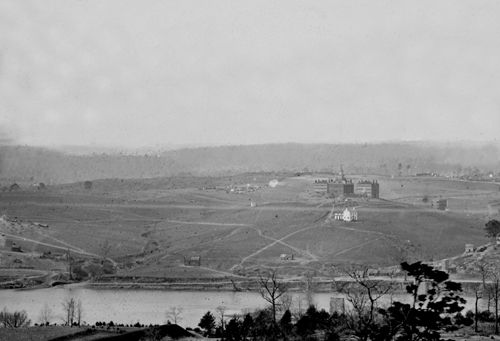
Knoxville seen from the south bank of Tennessee River, East Tennessee University in the middle distance, George N. Barnard, about 1864.
A series of battles and maneuvers in East Tennessee during the fall of 1863. Union forces under Major General Ambrose Burnside occupied Knoxville, Tennessee, and Confederate forces under Lieutenant General James Longstreet were detached from General Braxton Bragg’s Army of Tennessee at Chattanooga to prevent Burnside’s reinforcement of the besieged Union forces there. Ultimately, Longstreet’s own siege of Knoxville ended when Union Major General William T. Sherman led the Army of the Tennessee and other troops to Burnside’s relief after Union troops had broken the Confederate siege of Chattanooga. Although Longstreet was one of General Robert E. Lee’s best corps commanders in the East, he was unsuccessful in his role as an independent commander in the West and accomplished little in the Knoxville Campaign.
Campbell’s Station (November 16, 1863) – In early November 1863, Lieutenant General James Longstreet, with two divisions and about 5,000 cavalry troops, was detached from the Confederate Army of Tennessee near Chattanooga to attack Major General Ambrose E. Burnside’s Union Department of the Ohio troops at Knoxville, Tennessee. Following parallel routes, Longstreet and Burnside raced for Campbell’s Station, a hamlet where the Concord Road, from the south, intersected the Kingston Road to Knoxville. Burnside hoped to reach the crossroads first and continue to safety in Knoxville; Longstreet planned to reach the crossroads and hold it, which would prevent Burnside from gaining Knoxville and force him to fight outside his earthworks. On a rainy November 16, Major General Ambrose E. Burnside’s advance reached the vital intersection and deployed first by forced marching. The main column arrived at noon with the baggage train just behind. Scarcely 15 minutes later, Longstreet’s Confederates approached. Longstreet attempted a double envelopment: attacks timed to strike both Union flanks simultaneously. Major General Lafayette McLaw’s Confederate division struck with such force that the Union right had to redeploy but held. Brigadier General Micah Jenkins’s Confederate division maneuvered ineffectively as it advanced and was unable to turn the Union left. Burnside ordered his two divisions astride the Kingston Road to withdraw three-quarters of a mile to a ridge in their rear. This was accomplished without confusion. The Confederates suspended their attack while Burnside continued his retrograde movement to Knoxville. Had Longstreet reached Campbell’s Station first, the Knoxville Campaign’s results might have been different. The Union victory resulted in estimated casualties of 400 Union and 570 Confederate.
Siege of Knoxville (November 17-December 4, 1863) – On November 17, the bulk of Union Major General Ambrose E. Burnside’s army was within Knoxville’s defensive perimeter, Tennessee, and the Siege of Knoxville began. The Confederates were not equipped for siege operations and were running short on supplies. On November 18, Union Brigadier General William P. Sanders, leading the cavalry that was screening Burnside’s withdrawal, was mortally wounded in a skirmish. In the meantime, Confederate Lieutenant General James Longstreet planned an attack as early as November 20. Still, he delayed, waiting for reinforcements under Brigadier General Bushrod Johnson (3,500 men) and the cavalry brigade of General William “Grumble” Edmondson Jones. Longstreet’s artillery chief, Colonel Edward Porter Alexander, wrote that “every day of delay added to the strength of the enemy’s breastworks.” Longstreet’s troops sealed off all approaches to Knoxville, hoping to starve the garrison into submission. Longstreet and his chief engineer, Brigadier General Danville Leadbetter, determined that the old Confederate Fort Loudon (renamed Fort Sanders by the Federals) offered the weakest link.
Assault on Fort Sanders, Kurz and Allison, 1891.
Fort Sanders (November 29, 1863) – Also called the Battle of Fort Loudon, this battle took place as part of the Confederates’ determination to take Knoxville, Tennessee. The Confederates decided that the old fort was the only vulnerable place to penetrate Union Major General Ambrose E. Burnside’s fortifications, which enclosed the city and successfully concluded the siege, already a week long. The fort surmounted an eminence just northwest of Knoxville. Northwest of the fort, the land dropped off abruptly. Confederate Lieutenant General James Longstreet believed he could assemble a storming party, undetected at night, below the fortifications and, before dawn, overwhelm Fort Sanders by a coup de main. Following a brief artillery barrage directed at the fort’s interior, three Rebel brigades charged. Union wire entanglements-–telegraph wire stretched from one tree stump to another-–delayed the attack, but the fort’s outer ditch halted the Confederates.
This ditch was twelve feet wide and from four to ten feet deep with vertical sides. The fort’s exterior slope was almost vertical, also. Crossing the ditch was nearly impossible, especially under withering defensive fire from musketry and canister. Confederate officers did lead their men into the ditch, but without scaling ladders, few emerged on the scarp side, and a small number entered the fort to be wounded, killed, or captured. The attack lasted a short 20 minutes. Longstreet undertook his Knoxville expedition to divert Union troops from Chattanooga and get away from General Braxton Bragg, with whom he was engaged in a bitter feud. His failure to take Knoxville scuttled his purpose. This was the decisive battle of the Knoxville Campaign. This Confederate defeat, plus the loss of Chattanooga on November 25`, put much of East Tennessee in the Union camp. The engagement resulted in an estimated 100 Union casualties and 780 Confederate. When Longstreet learned of General Bragg’s route from Chattanooga and Sherman’s approach from the south, he lifted the siege on December 4 and withdrew into winter quarters in upper East Tennessee.
Bean’s Station (December 14, 1863) – Lieutenant General James Longstreet abandoned the Siege of Knoxville on December 4, 1863, and retreated northeast towards Rogersville, Tennessee. Union Major General John G. Parke pursued the Confederates but not too closely. Longstreet continued to Rutledge on December 6 and Rogersville on the 9th. Parke sent Brigadier General J.M Shackelford on with about 4,000 cavalry and infantry troops to search for Longstreet.
On December 13, Shackelford was near Bean’s Station on the Holston River in present-day Grainger County, Tennessee. Longstreet decided to go back and capture Bean’s Station. Three Confederate columns and artillery approached Bean’s Station to catch the Federals in a vice. By 2:00 a.m. on December 14, one column was skirmishing with Union pickets. The pickets held out as best they could and warned Shackelford of the Confederate presence. He deployed his force for an assault. Soon, the battle started and continued throughout most of the day. Confederate flanking attacks and other assaults occurred at various times and locations, but the Federals held until Southern reinforcements tipped the scales. By nightfall, the Federals were retiring from Bean’s Station through Bean’s Gap and Blain’s Cross Roads. Longstreet set out to attack the Union forces again the next morning, but as he approached them at Blain’s Cross Roads, he found them well-entrenched. Longstreet withdrew, and the Federals soon left the area. The Knoxville Campaign ended following the battle of Bean’s Station. Longstreet soon went into winter quarters at Russellville. Their success meant little to Confederate efforts except to prevent disaster. The Confederate victory resulted in estimated casualties of this battle were 700 Union and 900 Confederate.
Operations about Dandridge (December 1863-January 1864)
Wanting to push the Confederates out of their winter headquarters and having received reports of good forage south of the French Broad River, Union forces under Major General John G. Parke advanced on the Dandridge area, with orders to cross the river and occupy the area for the Federals. This movement forced Confederate Lieutenant General James Longstreet, operating around Dandridge, to fall back beyond Kimbrough’s Crossroads.
Mossy Creek (December 29, 1863) – Union Brigadier General Samuel D. Sturgis received a report on the night of December 28, 1863, that a Confederate Cavalry brigade was in the neighborhood of Dandridge that afternoon. Surmising that the cavalry force was split, Sturgis decided to meet, defeat, and possibly capture this portion. He ordered most of his troopers out toward Dandridge on two roads. After these troops had left, Major General William T. Martin, commander of Longstreet’s Confederate cavalry, now reunited, attacked the remainder of Sturgis’s force at Mossy Creek at 9:00 a.m.
First, Sturgis sent messages to his subordinates on the way to Dandridge to return promptly if they found no enemy there. The Confederates advanced, driving the Federals in front of them. Some of the Union troopers who had set out for Dandridge returned. Around 3:00 p.m., fortunes changed as the Federals began driving back the Confederates.
By dark, the Rebels were back to the location from which they had begun the battle. Union pursuit was not mounted that night, but Martin retreated from the area. After the victory at Mossy Creek, the Union held the line about Talbott’s Station for some time. The Union victory resulted in estimated casualties of 151 Union. The number of Confederate casualties is unknown.
Dandridge (January 17, 1864) – Union forces under Major General John G. Parke advanced on Dandridge, Tennessee, near the East Tennessee & Virginia Railroad, on January 14, forcing Lieutenant General James Longstreet’s Confederate troops to fall back. However, Longstreet moved additional troops into the area on January 15 to meet the enemy and threaten the Union base at New Market. On the 16th, Brigadier General Samuel D. Sturgis, commanding the Cavalry Corps, Army of the Ohio, rode forward to occupy Kimbrough’s Crossroads. As the Union cavalry neared the crossroads, they discovered an enemy infantry division with artillery that had arrived the day before. The Union cavalry could not dislodge these Rebels and was compelled to retire to Dandridge. About noon the next day, Sturgis received information that the Confederates were preparing for an attack, so he formed his men into the line of battle. At about 4:00 p.m., the Confederates advanced, and the fighting began. The battle continued until after dark, with the Federals occupying about the same battle line as when the fighting started. The Union forces fell back to New Market and Strawberry Plains during the night, but the Rebels were unable to pursue them because of the lack of cannons, ammunition, and shoes. For the time being, the Union forces left the area. Though considered a Confederate victory, they had failed to destroy or capture the Federals. The estimated casualties were 150 Union; the number of Confederates is unknown.
Fair Garden (January 27, 1864) – After the Battle of Dandridge, the Union cavalry moved to the south side of the French Broad River, disrupted Confederate foraging, and captured numerous wagons in that area. On January 25, 1864, Lieutenant General James Longstreet, commander of the Department of East Tennessee, instructed his subordinates to do something to curtail Union operations south of the French Broad. On the 26th, Brigadier General Samuel D. Sturgis, having had various brushes with Confederate cavalry, deployed his troopers to watch the area fords.
Two Confederate cavalry brigades and artillery advanced from Fair Garden in the afternoon but were checked about four miles from Sevierville. Other Confederates attacked a Union cavalry brigade at Fowler’s on Flat Creek and drove it about two miles. No further fighting occurred that day. Union scouts observed that the Confederates had concentrated on the Fair Garden Road, so Sturgis ordered an attack there in the morning. In a heavy fog, Colonel Edward M. McCook’s Union division attacked and drove back Major General William T. Martin’s Confederates until about 4:00 p.m. At that time, McCook’s men charged with sabers and routed the Rebels. Sturgis set out in pursuit on February 28, capturing and killing more of the routed Rebels. The Union forces, however, observed three of Longstreet’s infantry brigades crossing the river. Sturgis decided to evacuate the area, realizing his weariness from fighting, lack of supplies, ammunition, weapons, and the enemy’s overwhelming strength. Sturgis determined to attack Brigadier General Frank C. Armstrong’s Confederate cavalry division before leaving, which he had learned was about three or four miles away on the river. Unbeknownst to the attacking Federals, Armstrong had strongly fortified his position, and three infantry regiments had arrived to reinforce him. Thus, the Union troops suffered severe casualties in the attack. The battle continued until dark when the Federals retired from the area. The Federals had won the big battle, but the fatigue of continual fighting and lack of supplies and ammunition forced them to withdraw. A Union victory, the battle resulted in an estimated 100 Union casualties and 165 Confederate.
Forrest’s Expedition into West Tennessee and Kentucky (March-April 1864)
In March 1864, Confederate Major General Nathan Bedford Forrest set out from Columbus, Mississippi, with a force of fewer than 3,000 men on a multipurpose expedition to recruit and re-outfit his troops and disperse the Federals from West Tennessee and Kentucky. The campaign consisted of two battles: Paducah, Kentucky, and the other at Fort Pillow, Tennessee.
Fort Pillow Massacre, Tennessee.
Fort Pillow (April 12, 1864) – In April 1864, Union garrisons under Majors Lionel F. Booth and William F. Bradford were originally at Fort Pillow, a Confederate-built earthen fortification. However, two years earlier, it had been occupied by Union troops, who had also built an inner redoubt. Overlooking the Mississippi River about forty river miles above Memphis, the troops comprised 295 white Tennessee soldiers and 262 U.S. Black soldiers, all under Major Lionel F. Booth’s command. Confederate Major General Nathan Bedford Forrest attacked the fort on April 12 with a cavalry division of approximately 2,500 men. Forrest seized the older outworks, with high knolls commanding the Union position, to surround Booth’s force. Rugged terrain prevented the gunboat New Era from providing effective fire support for the Federals.
The garrison was unable to depress its artillery enough to cover the fort’s approaches, and Rebel sharpshooters on the surrounding knolls began firing into the fort, killing Major Booth. Major William F. Bradford then took over command of the garrison. The Confederates launched a determined attack at 11:00 a.m., occupying more strategic locations around the fort, and Forrest demanded unconditional surrender. Bradford asked for an hour for consultation, and Forrest granted twenty minutes. Bradford refused to surrender, and the Confederates renewed the attack, soon overran the fort, and drove the Federals down the river’s bluff into a deadly crossfire. Casualties were high, and only 62 of the U.S. Black Troops survived the fight. Many accused the Confederates of perpetrating the black troops’ massacre, a controversy that continues to this day. The Confederates evacuated Fort Pillow that evening, so they gained little from the attack except for a temporary disruption of Union operations. The “Fort Pillow Massacre” became a Union rallying cry and cemented resolve to see the war through to its conclusion. The Confederate victory resulted in estimated casualties of 654 Union and 80 Confederate.
Forrest’s Defense of Mississippi (June-August 1864)
Union Major General A.J. Smith, commanding a combined force of more than 14,000 men, left LaGrange, Tennessee, on July 5, 1864, and advanced south. Smith’s mission was to ensure that Major General Nathan Bedford Forrest and his cavalry did not raid Major General William T. Sherman’s railroad lifeline in Middle Tennessee, preventing supplies from reaching him in his campaign against Atlanta. The first two battles of the campaign were fought in Mississippi at Tupelo and Brice’s Cross Roads. The third and final battle of the campaign was waged at Memphis, Tennessee.
Confederate Major General Nathan B. Forrest’s raid on Memphis on August 21, 1864, by Harper’s Weekly.
Memphis (August 21, 1864) – At 4:00 a.m. on August 21, 1864, Confederate Major General Nathan Bedford Forrest made a daring raid on Union-held Memphis, Tennessee, occupied by 6,000 Federal troops. The raid was not an attempt to capture the city; rather, it had three other objectives: to capture three Union generals posted there, to release Southern prisoners from Irving Block Prison, and to cause the recall of Union forces from Northern Mississippi. Striking northwestward for Memphis with 2,000 cavalry troops, Forrest lost about a quarter of his strength because of exhausted horses. Surprise was essential. The Confederates eliminated the sentries by taking advantage of a thick dawn fog and claiming to be a Union patrol returning with prisoners.
Galloping through the streets and exchanging shots with other Union troops, the raiders split to pursue separate missions. One Union general was not at his quarters, and another escaped to Fort Pickering dressed in his nightshirt. Irving Block Prison’s attack also failed when Union troops stalled the State Female College’s main body. After two hours, Forrest decided to withdraw, cutting telegraph wires and taking 500 prisoners and large quantities of supplies, including many horses. Although Forrest failed in Memphis, his raid influenced Union forces to return from northern Mississippi and provide protection. The Confederate victory resulted in an estimated 160 Union casualties and 34 Confederate.
Franklin-Nashville Campaign (September-December 1864)
Nashville, Tennessee from Fort Negley looking northeast, George N. Barnard, 1864.
The Franklin-Nashville Campaign, also known as Hood’s Tennessee Campaign, was a series of battles in the Western Theater, conducted from September 18 to December 27, 1864, in Alabama, Tennessee, and northwestern Georgia. The Confederate Army of Tennessee under Lieutenant General John Bell Hood drove north from Atlanta, threatening Major General William T. Sherman’s communications and central Tennessee lines. After a brief attempt to pursue Hood, Sherman returned to Atlanta and began his March to the Sea, leaving Union forces under Major General George H. Thomas to deal with Hood’s threat. The first two battles of the campaign were fought in Allatoona, Georgia, and Decatur, Alabama. Six more battles would be fought in Tennessee before the campaign ended.
Johnsonville (November 4-5, 1864) – To check the army’s advance through Georgia, Major General Nathan Bedford Forrest led a 23-day raid culminating in an attack on the Yankee supply base at Johnsonville, Tennessee. Swinging north from Corinth, Mississippi, toward the Kentucky border and temporarily blockading the Tennessee River at Fort Herman, Forrest then moved southward along the Tennessee River’s west bank, capturing several U.S. steamers and a gunboat, which he later had to abandon. On November 4, Forrest began positioning his artillery across the river from the Federal supply base and landing at Johnsonville. They discovered the Confederates finishing their entrenchments and battery emplacements in the afternoon of the 4th. The gunboats and land batteries across the river engaged the Confederates in an artillery duel. The Rebel guns, however, were so well-positioned that the Federals were unable to hinder them. In fact, Confederate artillery fire disabled the gunboats. Fearing that the Rebels might cross the river and capture the transports, the Federals set fire to them. The wind then extended the fire to the piles of stores on the levee and a warehouse loaded with supplies. Seeing the fire, the Confederates began firing on the steamboats, barges, and warehouses to prevent the Federals from putting out the fire. An inferno illuminated Forrest’s night withdrawal, and he escaped clutches without serious loss. Damages totaled $2.2 million. On November 5, some Confederate artillery bombarded the depot in the morning but then left. Although this brilliant victory further strengthened Forrest’s reputation and destroyed a great amount of material, it failed to stem the tide of success in Georgia. The number of casualties is unknown.
Columbia (November 24-29, 1864) – Conflict near Columbia, Tennessee, during Confederate General John Bell Hood’s 1864 Tennessee invasion constituted a Confederate diversion as part of a maneuver designed to cross the Duck River upstream and cut off the army’s line of communications with Nashville. General John Bell Hood’s army advanced northeastward from Florence, Alabama. Major General John M. Schofield’s force quickly withdrew from Pulaski to Columbia, arriving on November 24, just ahead of Forrest’s Confederate Cavalry. The Federals built two lines of earthworks south of the town while skirmishing with enemy cavalry on November 24 and 25. Hood advanced his infantry on the following day but did not assault. He made demonstrations along the front while marching two corps of his army to Davis Ford, some five miles eastward on the Duck River. Schofield correctly interpreted Hood’s moves, but foul weather prevented him from crossing to the north bank before November 28, leaving Columbia to the Confederates. The next day, both armies marched north for Spring Hill. Schofield had slowed Hood’s movement but had not stopped him. A Confederate victory, the number of casualties is unknown.
Spring Hill (November 29, 1864) – Spring Hill was the prelude to Franklin’s Battle. On the night of November 28, 1864, General John Bell Hood’s Army of Tennessee marched toward Spring Hill to get astride Major General John M. Schofield’s army’s lifeline. Cavalry skirmishing between Brigadier General James H. Wilson’s cavalry and Major General Nathan Bedford Forrest’s Confederate troopers continued throughout the day as the Confederates advanced. On November 29, Hood’s infantry crossed Duck River and converged on Spring Hill. In the meantime, Major General Schofield reinforced the troops holding the crossroads at Spring Hill. In the late afternoon, the Federals repulsed a piecemeal Confederate infantry attack. During the night, the rest of Schofield’s command passed from Columbia through Spring Hill to Franklin. This was, perhaps, Hood’s best chance to isolate and defeat the army. The engagement has been described as “one of the most controversial non-fighting events of the entire war.” The number of casualties of the victory is unknown.
Battle of Franklin. November 30, 1864, Kurz and Allison, 1891.
Franklin (November 30, 1864) – Having lost a good opportunity at Spring Hill to hurt the Army significantly, Confederate General John B. Hood marched in rapid pursuit of Major General John M. Schofield’s retreating Army. Schofield’s advance reached Franklin about sunrise on November 30 and quickly formed a defensive line in works thrown up by the Yankees in the spring of 1863 on the southern edge of town. Schofield wished to remain in Franklin to repair the bridges and get his supply trains over them. Skirmishing at Thompson’s Station and elsewhere delayed Hood’s march, but around 4:00 p.m., he marshaled a frontal attack against the perimeter. Two Federal brigades holding a forward position gave way and retreated to the inner works, but their comrades ultimately held a battle that caused frightening casualties. When the battle ceased after dark, six Confederate generals were dead or had mortal wounds. Despite this terrible loss, Hood’s army, late, depleted, and worn, crawled toward Nashville. The victory resulted in an estimated 2,326 casualties and 6,262 Confederate.
Murfreesboro (December 5-7, 1864) – Also called the Battle of Wilkinson Pike and the Battle of Cedars, this conflict occurred in Rutherford County, Tennessee. In another attempt to force Major General William T. Sherman’s army out of Georgia, General John Bell Hood led the Army of Tennessee north toward Nashville in November 1864. Although he suffered a terrible loss at Franklin, he continued toward Nashville. In operating against Nashville, he decided that destroying the Nashville & Chattanooga Railroad and disrupting the army supply depot at Murfreesboro would help his cause. He sent Major General Nathan Bedford Forrest on December 4 with an expedition composed of two cavalry divisions and Major General William B. Bate’s infantry division to Murfreesboro.
On December 2, Hood ordered Bate to destroy the railroad and blockhouses between Murfreesboro and Nashville and join Forrest for further operations. On December 4, Bate’s division attacked Blockhouse No. 7, which was protecting the railroad crossing at Overall Creek, but forces fought it off. On the morning of December 5, Forrest headed out toward Murfreesboro, splitting his force, one column to attack the fort on the hill and the other to take Blockhouse No. 4, both at La Vergne. Upon his demand for surrender at both locations, the garrisons did so. Outside La Vergne, Forrest hooked up with Bate’s division, and the command advanced on to Murfreesboro along two roads, driving the Yankees into their Fortress and encamped in the city outskirts for the night. The next morning, on December 6, Forrest ordered Bate’s division to “move upon the enemy’s works.” Fighting flared for a couple of hours, but the Yankees ceased firing, and both sides glared at each other for the rest of the day. Confederate Brigadier General Claudius Sears’s and Brigadier General Joseph B. Palmer’s infantry brigades joined Forrest’s command in the evening, further swelling his numbers. On the morning of December 7, Major General Lovell Rousseau, commanding all of the forces at Murfreesboro, sent two brigades out under Brigadier General Robert Milroy on the Salem Pike to feel out the enemy. These troops engaged the Confederates, and fighting continued. At one point, some of Forrest’s troops broke and ran, causing disorder in the Rebel ranks; even entreaties from Forrest and Bate did not stem the rout of these units. The rest of Forrest’s command conducted an orderly retreat from the field and encamped for the night outside Murfreesboro. Forrest had destroyed railroad tracks, blockhouses, and some homes and generally disrupted operations in the area. The victory resulted in an estimated 225 casualties and 197 Confederate.
Federal outer line in Nashville, December 16, 1864, George N. Barnard.
Nashville (December 15-16, 1864) – In a last desperate attempt to force Major General William T. Sherman’s army out of Georgia, General John Bell Hood led the Army of Tennessee north toward Nashville in November 1864. Although he suffered terrible losses at Franklin on November 30, he continued toward Nashville. By the next day, Major General George H. Thomas’s army’s various elements had reached Nashville. Hood reached the outskirts of Nashville on December 2, occupied positions on a line of hills parallel to those of the, and began erecting fieldworks. Army Engineer Brigadier General James St. Clair Morton had overseen the construction of sophisticated fortifications at Nashville in 1862-63, strengthened by others, which would soon see use. From December 1 through December 14, Thomas made preparations for the Battle of Nashville, in which he intended to destroy Hood’s army. On the night of December 14, Thomas informed Major General Henry W. Halleck, acting as Major General Ulysses S. Grant’s chief of staff, to attack the next day. Thomas planned to strike both of Hood’s flanks.
Before daylight on December 15, the first of the troops, led by Major General James Steedman, set out to hit the Confederate right. The attack was made, and the forces held down one Rebel corps there for the rest of the day. Attack on the Confederate left did not begin until the afternoon when a charge commenced on Montgomery Hill. With this classic charge’s success, attacks on other parts of the Confederate left commenced, eventually successful. By this time, it was dark, and the fighting stopped for the day. Although battered and with a much smaller battle line, General Hood was still confident. He established a main line of resistance along the base of a ridge about two miles south of the former location, throwing up new works and fortifying Shy’s and Overton’s Hills on their flanks. The 4th Army Corps marched out to within 250 yards, in some places, of the Confederate’s new line and began constructing fieldworks. Other troops moved out toward the new Confederate line during the rest of the morning and took up positions opposite it. The attack began against Hood’s strong right flank on Overton’s Hill. The same brigade that had taken Montgomery Hill the day before received the nod for the charge up Overton’s Hill. Although gallantly conducted, this charge failed, but other troops under Major General A.J. Smith successfully assaulted Shy’s Hill on their fronts. Seeing the success along the line, other troops charged up Overton’s Hill and took it. Hood’s army fled. Thomas had left one escape route open, but the army set off in pursuit. For ten days, the pursuit continued until the beaten and battered Army of Tennessee re-crossed the Tennessee River. Hood’s army was stalled at Columbia, beaten at Franklin, and routed at Nashville. Hood retreated to Tupelo and resigned his command. Resulting in a clear victory, the estimated casualties were 2,140 and 4,462 Confederate.
Breckenridge’s Advance into East Tennessee (November 1864)
In November 1864, Confederate Major General John C. Breckinridge undertook an expedition into East Tennessee from Virginia to secure the countryside for food and forage and drive the Federals from the area. Breckinridge anticipated that Confederate sympathizers would join his force and help drive the Yankees from the area. In the meantime, a Federal force under the command of Brigadier General Alvan C. Gillem had advanced beyond Greeneville but retired in front of the larger Confederate force moving out of Jonesborough towards Greeneville. In the hopes of protecting the rail lines to Knoxville, the Federals fell back to Bull’s Gap east-southeast of Whitesburg on the East Tennessee & Virginia Railroad.
Bull’s Gap (November 11-13, 1864) – On November 10, forces were at Bull’s Gap on the East Tennessee & Virginia Railroad. The Confederates attacked them on the morning of November 11 but were repulsed by 11:00 a.m. Artillery fire continued throughout the day. The next morning, both sides attacked; the Confederates sought to hit the forces in various locations, but they gained little. The next day, firing occurred throughout most of the day, but the Confederates did not assault the lines because they were marching to flank them on the right. Before making the flank attack, the forces, short on everything from ammunition to rations, withdrew from Bull’s Gap after midnight on November 14. Breckinridge pursued, but the Federals received reinforcements, and foul weather played havoc with the roads and streams. Breckinridge, with most of his force, retired back to Virginia. This victory was a temporary setback in the Federal plans to rid East Tennessee of Confederate influence. The Confederate victory resulted in an estimated 241 casualties. The number of Confederate casualties is unknown.
Compiled and edited by Kathy Alexander/Legends of America, updated May 2024. Source: National Park Service
Also See:
Western Theater of the Civil War
Eastern Theater of the Civil War
Civil War Trans-Mississippi & Pacific Coast Theaters
Lower Seaboard Theater & Gulf Approach of the Civil War
The Civil War (main page)
